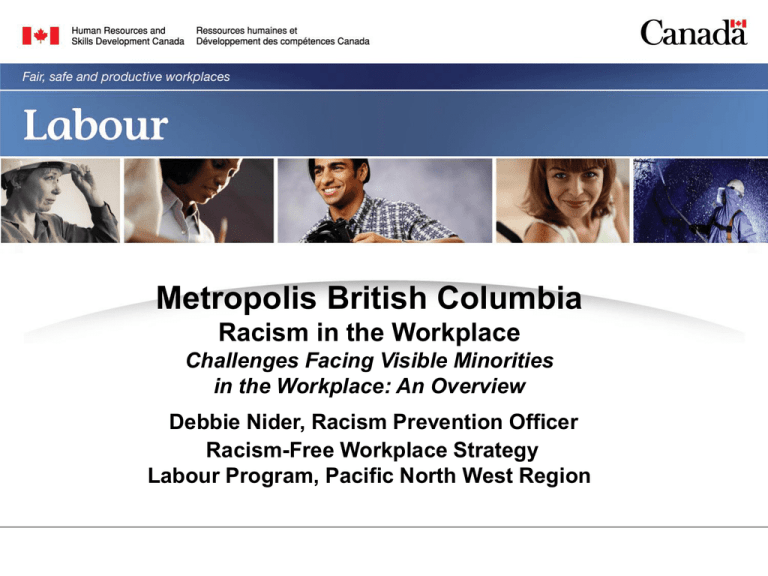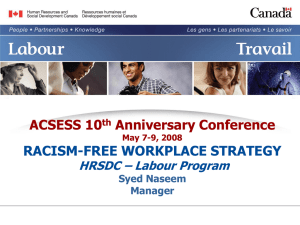
Metropolis British Columbia
Racism in the Workplace
Challenges Facing Visible Minorities
in the Workplace: An Overview
Debbie Nider, Racism Prevention Officer
Racism-Free Workplace Strategy
Labour Program, Pacific North West Region
Canada’s Legal Framework for Diversity
1947 – Canadian Citizenship Act
1948 – International Convention on the Prevention and Punishment of
the Crime of Genocide (Canadian ratification in 1952) & Universal
Declaration of Human Rights
1958 – International Convention concerning Discrimination in Respect
of Employment and Occupation (Canadian ratification in 1964)
1960 – Canadian Bill of Rights
1963 – Establishment of the Royal Commission on Bilingualism and
Biculturalism
1965 – International Convention on the Elimination of All Forms of
Racial Discrimination (Canadian ratification in 1970)
1969 – Official Languages Act
1971 – Canada’s Multiculturalism Policy
Canada’s Legal Framework for Diversity
1976 – Immigration Act
1977 – Canadian Human Rights Act
1979 – Convention on the Elimination of All forms of Discrimination
against Women (Canadian ratification in 1981)
1982 – Canadian Charter of Rights and Freedoms
1984 – Special Parliamentary Committee Report, Equality Now, calls
for a multiculturalism act
1985 – Equality Rights article (Section 15) of the Cdn. Charter of
Rights and Freedoms enters into force
1986 – Employment Equity Act
1988 – Canadian Multiculturalism Act
1990 – Canadian Race Relations Foundation Act
Racism Free Workplace Strategy
Part of the “Canada’s Action Plan Against Racism”
– Canadian Heritage
– Justice Canada
– Citizenship & Immigration Canada
– HRSDC – Labour Program
Racism Free Workplace Strategy
– Remove employment barriers and promote the upward
mobility of Visible Minorities and Aboriginal Peoples
8 RPOs - Vancouver, Calgary, Winnipeg, Toronto, Montréal &
Halifax
RPO Role – Who We Work With
Employers within the:
– Federal Contractors Program (FCP) &
– Legislated Employment Equity Program (LEEP)
Workplace Equity Officers & Workplace Equity
Technical Advisors
Stakeholder organizations such as:
–
–
–
–
Visible Minority & Aboriginal Communities
Federal, Provincial, Municipal and Territorial Governments
Federal & Provincial Human Rights Commissions
Unions
Challenges Facing Visible Minorities in the
Workplace
Recognition of credentials and experience
Lack of money, lack of computer skills, loss of selfconfidence, lack of space in daycare centres
Language – lack of French and/or English skills
Cultural barriers – lack of information about the labour
market and its rules
Systemic obstacles
Discrimination and racism
Racism
Any action, policy, practice or behaviour
which is detrimental to a person or group of
persons, which limits or denies a person or
group of persons opportunities, privileges,
roles or rewards based on race.
Stereotyping in the Workplace and Impacts on
Visible Minorities
Stereotypes are:
Generalizations used to distinguish a group
Typically exaggerated or oversimplified descriptions
Often offensive
The foundation of prejudice and discrimination
‘Positive’ and ‘Negative’
Barriers to Inclusion: Interviewing and NonVerbal Differences / “Body Language”
Mainstream
Minimal Eye Contact
Meaning
Cultures
Avoidant
Hiding Something
Not Trustworthy
Respect Authority
Non-Aggressive
Polite
Aboriginal
Japanese
Chinese
Head movements
Shake means ‘no’ or
‘I’m not sure
Lack of confidence
Shake means ‘yes,’ ‘I
agree,’ ‘I am listening
and understand your
point’
Pakistan, Southern
India
Language Styles
Short abrupt answers
mean not friendly,
impolite, uneducated
Curt phrases are limited
for courtesy
Aboriginal
Insecurity
Lack of knowledge
Disinterest
Reserve
Show Respect for
person
Give thought to
responses
Aboriginal
Eastern cultures
Silence
CHRC Prohibited Grounds
Race
National or Ethnic Origin
Colour
Age
Sexual Orientation
Marital Status
Sex (including pregnancy)
Religion
Disability
Family Status
Pardoned Conviction
Demographics: Visible Minorities 2006 Census
Canada’s total population = 31,241,030
Visible Minorities accounted for 16.2% of Canada’s
total population = 5,068,100
The Visible Minority population increased 5 times
faster than the growth rate of the total population
This trend is expected to continue well into 2017
Growth in Visible Minority population due to
newcomers to Canada
Demographics Visible Minorities con’t..
Chinese and Blacks are respectively the 2nd and 3rd
largest Visible Minority groups (South Asians are #1).
96% of Visible Minority population live in a CMA
(census metropolitan area)
More than half of the Visible Minority workforce are
concentrated in ON (54%), BC (20%), QC (12%)
Visible Minorities are younger than the total
population. 46.5% are at the working age of 25-54.
Demographics Visible Minorities (con’t)
By the year 2011, immigration will be the sole source
of net labour force growth, and almost 90% of these
immigrants will be visible minorities
It is projected that by the year 2017:
One Canadian in five could be a Visible Minority
person
Half of the population in Toronto and Vancouver may
be Visible Minorities
BC Visible Minority Population (Statistics
Canada – Census 2006)
26%
9%
5%
4%
40%
16%
Chinese
South Asian
Filipino
Korean
Southeast Asian
Other
Projections 2031: from “Projections of the diversity of the
Canadian population, 2006-2031”, Statscan
Between 29%-32% of the population could belong to a visible
minority group as defined in the Employment Equity Act
Vast majority (96%) of people belonging to a visible minority
group would continue to live in one of the 33 census
metropolitan areas
By 2031: Visible minority groups would comprise
– 63% of Toronto
– 59% of Vancouver
– 38% of Calgary
– 31% of Montreal
Projections 2031: from a Leger Marketing Poll done for the
Association for Canadian Studies
Prediction – by 2031 one in three Canadians will belong to a
visible minority group and
One person in 4 will be foreign-born
The Abbotsford-Mission region is predicted to rank 3rd most
visibly diverse market (39% of the population) after Toronto and
Vancouver, slightly more than Calgary (38%)
RFWS Tools and Resources:
Training Workshops
Building A Business Case for Racial Diversity
Introduction to Diversity
Building Inclusive Workplaces
Diversity in the Canadian Workplace: Experiences of Visible
Minorities
Work for All: Stop Racism In the Workplace – an NFB
program
Inclusive Recruitment Strategies & Interviewing Techniques
Duty to Accommodate
Debbie Nider
Racism Prevention Officer
Racism Free Workplace Strategy
Email: Debbie.nider@labour-travail.gc.ca
Phone:604-872-4384 Ext. 783
Thank you!









